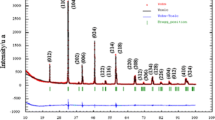Abstract
The thermopower, S, magnetothermopower, ΔS/S, resistivity, ρ, and magnetoresistivity, Δρ/ρ, depending on the temperature T and magnetic field H, have been studied in an Nd0.5Sr0.5MnO3 single crystal consisting of three types of clusters: an antiferromagnetic CE-type with charge-orbital ordering (below the Neel temperature T NCE ~ 145 K) and an A-type with T NA ~ 220 K; a ferromagnetic at 234 ≤ T ≤ 252 K, and a ferromagnetic metal phase below the Curie temperature T C = 248 K. The thermopower was found to be negative, indicating the dominance of the electronic type of conductivity. In the S(T) curves, a sharp minimum is observed in the temperature range of 100 K ≤ T ≤ 133 K, close to T NCE , where the absolute S value attains 53 μV/K. With a further increase in temperature, the absolute S value decreases rapidly; at 200 K it is equal to 7 μV/K. It then slightly increases, reaching its maximum value of 15 μV/K at a temperature of 254 K, which is close to T C . The absolute thermopower decreased under the influence of the magnetic field; i.e., a negative magnetothermopower occurs. In {ΔS/S}(T) curves, a sharp minimum is observed at T = 130 K close to T NCE , where the magnetothermopower reaches a huge value of ~45% at H = 13.23 kOe. A broad minimum in the {ΔS/S}(T) curves is observed near the Curie temperature and its value is also high, viz., ~15% in the maximum measuring magnetic field of 13.23 kOe. The extremely high magnetothermopower values mean that the charge-orbital ordered nanoclusters or ferron type make the main contribution to the thermopower of the entire sample. The behavior of the ρ(T) and {Δρ/ρ}(T) curves is similar to that of the S(T) and {ΔS/S}(T) dependencies, which is in agreement with this conclusion.
Similar content being viewed by others
References
E. L. Nagaev, Phys. Rep. 346, 387 (2001).
A. Yanase and T. Kasuya, J. Phys. Soc. Jpn. 25, 1025 (1968).
P. M. Woodward, D. E. Cox, T. Vogt, C. N. R. Rao, et al., Chem. Mater. 11, 3528 (1999).
R. Mahendiran, M. R. Ibarra, A. Maignan, et al., Phys. Rev. Lett. 82, 2192 (2000).
C. Ritter, R. Mahendiran, M. R. Ibarra, L. Morellon, et al., Phys. Rev. B 61, R9229 (2000).
H. Kawano, R. Kajimoto, H. Yoshizawa, H. Yomioka, et al., Phys. Rev. Lett. 78, 4253 (1997).
C.-H. Du, M. E. Ghazi, P. D. Hatton, S. P. Collins, et al., J. Appl. Phys. 104, 3517 (2008).
E. Dagoto, T. Hotta, and A. Moreo, Phys. Rep. 344, 1 (2001).
Author information
Authors and Affiliations
Corresponding author
About this article
Cite this article
Koroleva, L.I., Morozov, A.S., Zhakina, E.S. et al. The influence of magnetic and structural heterogeneity on thermopower, magnetothermopower, electrical resistivity, and magnetoresistivity of Nd0.5Sr0.5MnO3 manganite. Moscow Univ. Phys. 71, 118–122 (2016). https://doi.org/10.3103/S0027134916010112
Received:
Accepted:
Published:
Issue Date:
DOI: https://doi.org/10.3103/S0027134916010112




